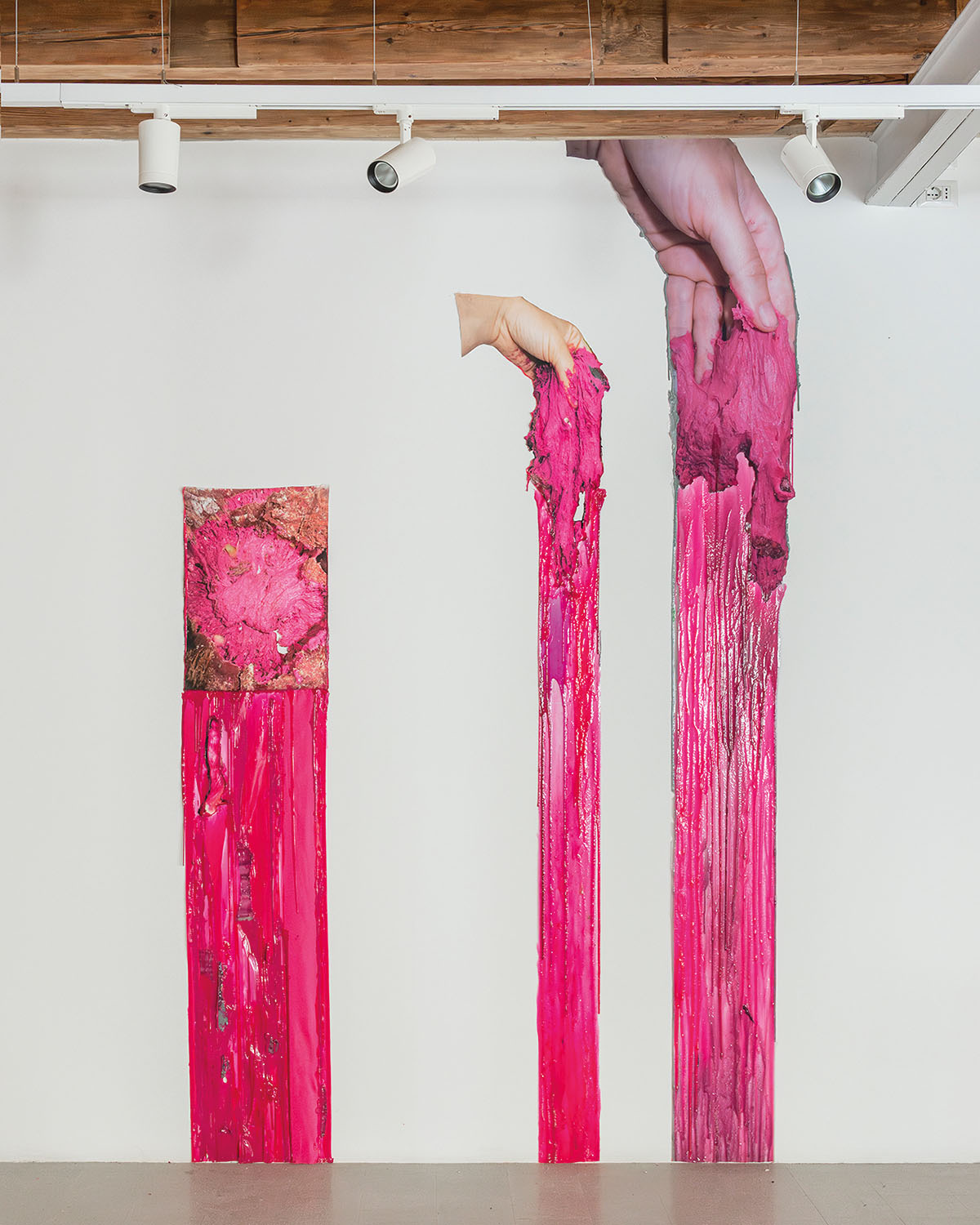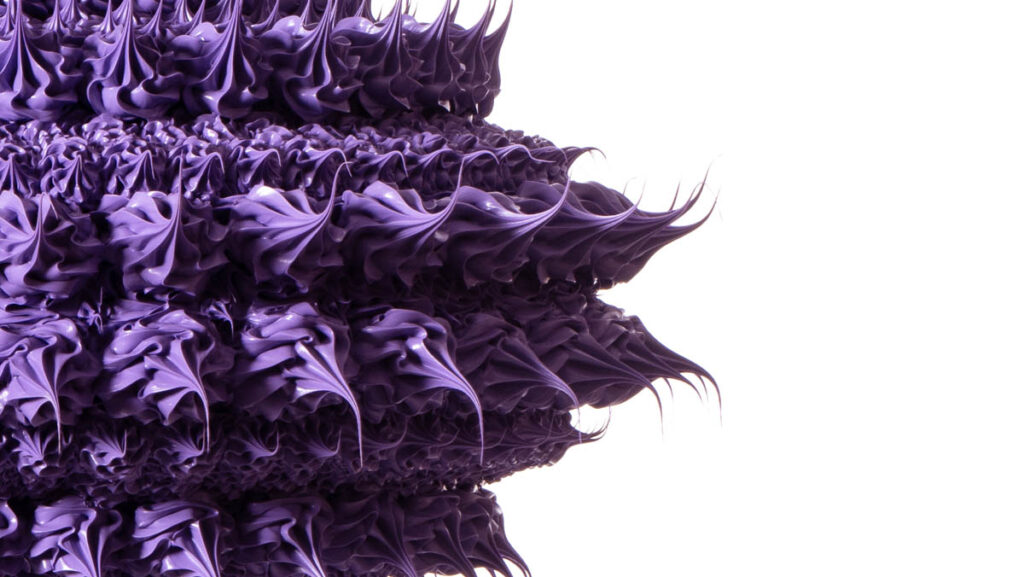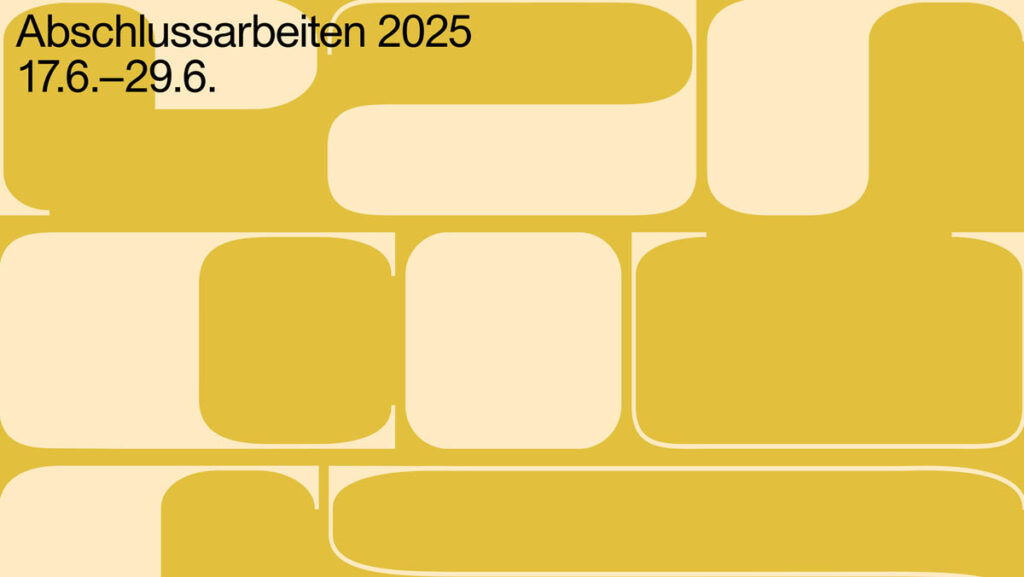
During their residencies in Rome — Dieckwisch at the German Academy Rome Villa Massimo, and White at the British School at Rome—the artists developed a creative dialogue centered around culinary experimentation, placing food at the core of their artistic practice.
For the exhibition at Fondazione Pastificio Cerere, Liza Dieckwisch presents a new series of paintings inspired by photographs of various Roman doughs. The photographs are printed on flexible fabric and are reworked directly in the exhibition space by Dieckwisch, expanding them into painterly compositions using silicone and pigment. The result is an installation that opens up into the space and questions the classical media of painting. Meanwhile, Laura White created a site-specific installation that investigates dough as a sculptural medium. The installation incorporates a low platform running through the center of the space, occupied and inhabited by his dough sculptures. Folds and ripples of dough will move across the surface with a sense of urgency, evoke the remnants of something once whole, like the ruins of a larger structure.
Writer Camilla Boemio engages in a captivating conversation with Laura White about the duo exhibition. She shares insights into their artistic process and inspiration.

How did the collaboration begin?
Laura: Liza and I were both resident in Rome at our country’s academies. I was at the British School at Rome, awarded the Ampersand Foundation Fellowship from Sept 2022 to June 2023 (nine months). Liza was at the German Academy for ten months. I visited Liza’s open studios at Villa Massimo (German Academy) in Oct 2022, and in her studio, she was exhibiting her work alongside pots of honey produced by beekeeper Erika Mayr. I sampled honey while looking at Liza’s wall pieces. I was interested in this relationship between an artist and a food producer, artworks and food, and I spoke to both Liza and Erika that evening and immediately connected. I kept bumping into Erika – at a conference and then in a market, and Liza was in contact via Instagram. Liza and I were drawn together through this relationship of art, food, and materiality. Liza and I recognized in each other and our art practices the influence we both had from food, the making and handling of food, visiting markets, and cooking.
The link between mine and Liza’s work is around materiality. My practice focuses on the engagement, collaboration, and handling of materials, a relationship between me and matter directly evidenced in the sculptures themselves. Whereas Liza’s materials are documented and explored through an expanded field of painting.
Liza: Our collaboration began in early 2023 during our respective stays at the German Academy and British School in Rome. Through a long chain of coincidences, we started cooking together regularly in January 2023. We had applied for our stay with relatively similar concepts, and therefore, it was a inspiring exchange for us that we had started in Rome. It’s important for me to emphasise that we hadn’t initially planned to exhibit together, but that it was purely about researching food, which we were very interested in. So at the beginning, it was a very informal cooking together, which has developed into an intensive artistic collaboration over the last few years.

During your past BSR residency, in 2022, you have explored the materiality of Roman food, with a particular interest in artisanal processes. Could you tell us about your methods and related problems that you used in this duo exhibition?
Laura: Being in Rome was a real awakening of the importance of food in my work. Not only seeing the abundance of food in the many Roman markets, eating in restaurants, cooking with people such as Rachel Roddy (food writer), and of course with Liza.
When I first arrived in Rome, I experimented with curing ham, making garum (ancient Roman fish sauce), tried various old Roman recipes, and made a lot of pasta. I had worked in dough before coming to Rome, but now I wanted to develop a recipe for dough to make sculptures – a material that behaved like dough and was made up of flour and water. During my time at the BSR, I made both edible and non-edible dough sculptures – pasta for eating and stable dough sculptures (non-edible), which you see in the exhibition at Pastifico Cerere.
During my time in Rome at the BSR, I developed a unique dough recipe for making these large dough shapes, a base of flour, water, salt, food colouring, plus other stabilizing ingredients. I’m interested in this material, not only for its humble ingredients, but also for its sustainable and biodegradable qualities. The materiality of dough is extraordinary, as anyone who has made pasta or bread will know. It is elasticated, transformative, it is alive, almost breathing, it is very bodily. When I make the individual dough pieces, I mix, then knead my dough material to build up the gluten, and then knead in food colouring to create its marble appearance. I rest it before stretching it. I use a rolling pin to roll it out, then I use my body to stretch it. E.g., I use my arms to pull the dough apart, and then along my body to stretch it more while supporting it. It is a very physical experience, where I am responding to the material constantly. Once the dough is quite thin, I manipulate it into shapes, then rest it over armatures I have built to allow the dough to dry and stabilize. I take a lot of care as my dough dries. Each day, watching and further manipulating it, exploring how it tears and rips. Over time, the dough dries hard, and I can place it without supports.
The plinths on which the installation sits have been carefully designed, selecting materials that are acquired directly from a building merchant – concrete blocks and MDF.

Liza: In addition to Roman art, I spent a lot of time in Rome researching Roman offal cuisine. When I read about dishes like pajata or coratella in my research for my stay, I knew that Rome would be a good place for my artistic research. My way of working is often very intuitive; I often only have a hunch that something might be of interest to me, and often only realise afterwards what and why something fascinated me so much. In Rome, I was particularly fascinated by the Roman wall frescoes and mosaics. The mosaic ‘The Unswept Floor’ by Heraclitus from the Vatican Museums, in particular, with its fragmentary depiction of leftover food, has influenced my paintings over the last two years.
How did the Roman culture influence you?
Laura: Rome has had a massive influence on me. My work often responds to both the everyday and high culture. I like to combine these two things, and for me, in Rome, I focused on Roman food and the art of the Baroque period, particularly the sculptures of Gian Lorenzo Bernini. I like to make parallels between, say, meat and marble. E.g., the marbled colours in a slice of raw meat and stone marble cladding, and the folds and forms of the innards of an animal, such as tripe, and the folds of fabric carved in stone for monuments and statues. I spent my time in Rome and travelling to surrounding areas visiting markets, salumeria, food festivals, bakeries, cheese makers, and pasta shops, while also searching out all the Bernini sculptures, such as in the Borghese gallery and the churches and Basilicas of Rome. My work often appears like remnants from something bigger, that was once whole. I spent a lot of time looking at Roman sculpture in the Museums – Centrale Montemartini, Massimo, and the Capitoline. There is no doubt that my fixation on Roman sculptures, especially the rendition of fabric carved in stone and the idea of fragments, the putting back together of stone sculptures that had been damaged, lost, and then restored, and then displayed in museums, has greatly influenced me.
The food culture of Rome has been very important. My practice is very much in the kitchen as well as in the studio now. In my studio in London, I am currently installing a bread oven so that I can make edible (bread) and non-edible sculpture in the same space.

You created in the exhibition a site-specific installation that investigates dough as a sculptural medium. There are reminiscences of marble fragments from a Baroque sculpture, rendering stone as soft as dough. There are elements allowing the material’s movement and resistance. Can you tell me more?
Laura: I like to use and create unfamiliar materials for my sculpture. Although the work is made of dough, it appears like stone, challenging the audience’s association and understanding of both stone and dough. This relationship between the humble ingredients of dough (flour and water) and valuable marble is brought together in my work, raising questions about how we might judge materials. Can dough be as valuable as stone? While dough is cheap to make, it is the basis of so many foods across countries and cultures, and of enormous value. Whereas Bernini carved stone to look fluid and as malleable as dough, my sculptures are made from a material that is soft, malleable, and transformative, and when dried, can look like stone, capturing the actual movement of the material rather than representing it.
Dough is an extraordinary material to work with, which is what I’m attracted to. It is stretchy but also resists being stretched. I use the weight of the material to stretch itself. Hanging it over and down my body to elongate and make it thinner. I like to push my materials to the limit – to breaking point – where they become too thin or tear and rip apart.
I capture in the sculpture the behaviour of the material, evidencing the material in motion. E.g., capturing the pulls and stretches in the material itself. But I also control the dough by placing it on armatures to create folds and forms. This play between control and relinquishing control to the material is my process and the outcome. I don’t plan too much what I do, I respond in the moment to the materials. This challenging and unpredictable process I find exciting and requires me to be in the present.

How did you make it in response to space?
Laura: The history of the building is key to my work – a former pasta factory. I worked in the space for over 3 weeks in the run up to the exhibition, making all the work on site. The gallery is large, and the work reflects the space, using the whole space as a studio to create all the works on display. While I was making the dough in this former pasta factory, it felt very poignant, bringing the material back into the space after so many years. The smell of fresh dough filled the space – the smell of a pasta factory.
I was also very interested in the architecture of the gallery space, the pillars that run through the center of the space, and the wooden ceiling, building the platforms that support the installation in response to these features. The work weaves between the pillars. The plinths are made of painted MDF raised on concrete bricks. The colour I chose for painting the platforms is warm like the wooden ceiling, sets the dough works off subtly, and connects to Liza’s work, which reveals hands and flesh. The functional platforms that incorporate building materials, such as the brick, connect to the functionality of the previous pasta factory and the process of making.
It was important to plan my work and the way to present it on these bespoke plinths in response to the space and Liza’s work. We were not interested in creating a collaborative installation, but to allow our cooking experiences together to feed into our practices independently and to allow our art practices to influence each other in an open and unforced way. A few weeks before we came to Rome, Liza came to my studio in London, where we brought together our materials, images, and ideas together. Since our Roman residence, we have met in person and online to cook many times. For example, we did a food event last August in London.

What are the artistic influences recurring throughout your work? Were there artists, theoretical interests, or experiences that led to this?
Liza: In addition to contemporary extended painting positions such as Jessica Stockholder or Polly Apfelbaum, baroque still life painting is currently an important reference for my work. I am particularly interested in the paintings of the Spanish painter Juan Sánchez Cotán (1560 -1627), which depict fruits and vegetables laid out and hanging accurately. I am interested in the unusual spatial representation and the precise placement of the individual pictorial elements. I see parallels to my paintings in the orderly and reduced staging.
In this exhibition do you explore the basic elements of painting to generate new form? How did food become central in your research topic?
Liza: Investigating the fundamentals of painting is a central focus of my artistic work. I am interested in fluid painting that does not require a support, such as canvas or paper. I am interested in painting that appears fluid, but stands in contrast to the hardened material. In my search for materials with which I could realize a kind of liquid painting, I have experimented with a wide variety of materials over many years and found more and more parallels to cooking: Today I mainly use spoons, silicone baking moulds, wagons, whisks, spatulas, etc. for my paintings instead brushes and palettes. Furthermore, I find the processes of cooking inspiring and important for my painting: the change of aggregate states, the idea that something only exists for a short time. I like to create a painting that is different depending on the situation and environment. For example, part of my work from this exhibition was shown last summer in a different context in an exhibition in Stuttgart. I simply don’t believe that something always stays the same.
The exhibition opens to the public from Wednesday, May 7, to Wednesday, June 11, 2025.
Address and contact:
Fondazione Pastificio Cerere
Via degli Ausoni, 7 00185 Rome
www.pastificiocerere.it
Camilla Boemio is a contributor covering contemporary art. She writes regularly for Spaghetti Boost, Curator, Exibart, The Dreaming Machine, Les Nouveaux Riches, and more. Her collaborative art book „The Edge of Equilibrium“, published by Vanilla Edizioni, in 2021, is in the collection of the Jean Paul Getty Museum in Los Angeles and in Archivio Storico ASAC La Biennale di Venezia.





